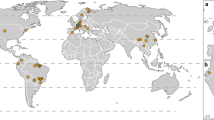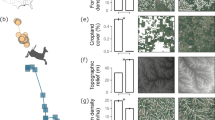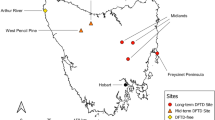Abstract
Biological invasions can represent important threats to endemic species, including those within the invaders’ food webs. The Asian common toad (Duttaphrynus melanostictus) was introduced to Madagascar in 2011. This introduction presents a potentially dangerous prey item to a relatively naïve, highly diverse endemic carnivore fauna. Using a multivariate niche modeling approach (background test), we assessed the predicted niche overlap between D. melanostictus and six endemic carnivores in eastern Madagascar. The overlap between this potential prey and predators was assessed on four environmental niche axes: temperature, precipitation, vegetation cover and elevation. Our results showed a mixture of niche overlap and divergence between D. melanostictus and the six carnivores for environmental axes tested. There was significant overlap with five of the carnivores on temperature and NDVI axes. On the precipitation axis, there was significant overlap between D. melanostictus with two species. Our results suggested that wide-ranging, locally rare carnivores may overlap extensively with D. melanostictus. The six carnivores that inhabit the eastern rainforest of Madagascar will likely share multiple, niche axes with this novel potential prey item. Species that eat the non-native common toad and are susceptible to its toxins are at conservation risk because their populations may not be robust enough to adapt quickly to this threat. We advocate closely monitoring these emerging interactions and suggest a preemptive conservation strategy for carnivores potentially at risk.


Similar content being viewed by others
References
Albignac R (1972) The carnivora of Madagascar. In: Biogeography and ecology in Madagascar. Springer, pp 667–682
Albignac R, Jolly A, Oberle P, Albignac R (1984) The carnivores. In: Jolly A, Oberle P, Albignac R (eds) Key environments: Madagascar. Pergamon Press, Oxford, pp 167–182
Anderson RP, Peterson AT, Gomez-Laverde M (2002) Using niche-based GIS modeling to test geographic predictions of competitive exclusion and competitive release in South American pocket mice. Oikos 98:3–16
Andreone F (2014) Risk review is under way for invasive toad. Nature 512:253
Beckmann C, Shine R (2009) Impact of invasive cane toads on Australian birds. Conserv Biol 23:1544–1549. doi:10.1111/J.1523-1739.2009.01261.X
Britt A, Virkaitis V (2003) Brown-tailed Mongoose Salanoia concolor in the Betampona Reserve, eastern Madagascar: photographs and an ecological comparison with ring-tailed Mongoose Galidia elegans. Small Carniv Conserv 28:1–3
Britt A, Welch C, Katz A (2001) The impact of Cryptoprocta ferox on the Varecia v. variegata reinforcement project at Betampona. Lemur News 6:35–37
Brockman DK, Godfrey LR, Dollar LJ, Ratsirarson J (2008) Evidence of invasive Felis silvestris predation on Propithecus verreauxi at Beza Mahafaly Special Reserve, Madagascar. Int J Primatol 29:135–152
Broennimann O, Guisan A (2008) Predicting current and future biological invasions: both native and invaded ranges matter. Biol Lett 4:585–589. doi:10.1098/Rsbl.2008.0254
Broennimann O, Treier UA, Muller-Scharer H, Thuiller W, Peterson AT, Guisan A (2007) Evidence of climatic niche shift during biological invasion. Ecol Lett 10:701–709. doi:10.1111/J.1461-0248.2007.01060.X
Brown KA, Spector S, Wu W (2008) Multi-scale analysis of species introductions: combining landscape and demographic models to improve management decisions about non-native species. J Appl Ecol 45:1639–1648. doi:10.1111/J.1365-2664.2008.01550.X
Cardillo M, Purvis A, Sechrest W, Gittleman JL, Bielby J, Mace GM (2004) Human population density and extinction risk in the world’s carnivores. PLoS Biol 2:909–914. ARTN e197. doi: 10.1371/journal.pbio.0020197
Cassey P, Hogg CJ (2015) Escaping captivity: the biological invasion risk from vertebrate species in zoos. Biol Conserv 181:18–26. doi:10.1016/J.Biocon.2014.10.023
Chen KK, Kovarikova A (1967) Pharmacology and toxicology of toad venom. J Pharm Sci 56:1535–1541
Costa GC, Wolfe C, Shepard DB, Caldwell JP, Vitt LJ (2008) Detecting the influence of climatic variables on species distributions: a test using GIS niche-based models along a steep longitudinal environmental gradient. J Biogeogr 35:637–646
Crawford AJ, Lips KR, Bermingham E (2010) Epidemic disease decimates amphibian abundance, species diversity, and evolutionary history in the highlands of central Panama. Proc Natl Acad Sci USA 107:13777–13782. doi:10.1073/Pnas.0914115107
Crottini A, Madsen O, Poux C, Strauß A, Vieites DR, Vences M (2012) Vertebrate time-tree elucidates the biogeographic pattern of a major biotic change around the K-T boundary in Madagascar. Proc Nat Acad Sci 109:5358–5363
Dollar L (1999) Preliminary report on the status, activity cycle, and ranging of Cryptoprocta ferox in the Malagasy rainforest, with implications for conservation. Small Carniv Conserv 20:7–10
Dunham AE (1998) Notes on the behavior of the Ring-tailed mongoose, Galidia elegans, at Ranomafana National Park, Madagascar. Small Carniv Conserv 19:21–24
Ehrenfeld JG (2010) Ecosystem consequences of biological invasions. Annu Rev Ecol Evol Syst 41:59–80
Elith J et al (2006) Novel methods improve prediction of species’ distributions from occurrence data. Ecography 29:129–151
Elith J, Leathwick JR (2009) Species distribution models: ecological explanation and prediction across space and time. Annu Rev Ecol Evol Syst 40(1):677
ESRI (2012) ArcGIS Desktop: Release 10.1. Environmental Systems Research Institute, Redlands
Farris ZJ (2014) Response of Madagascar’s endemic carnivores to fragmentation, hunting, and exotic carnivores across Masoala-Makira landscape. Dissertation, Virginia Tech, Blacksburg
Farris ZJ, Kelly MJ, Karpanty SM, Ratelolahy F, Andrianjakarivelo V, Holmes C (2012) Brown-tailed Vontsira Salanoia concolor (Eupleridae) documented in Makira Natural Park, Madagascar: new insights on distribution and camera-trap success. Small Carniv Conserv 47:82–86
Farris ZJ, Karpanty SM, Ratelolahy F, Kelly MJ (2014) Predator–primate distribution, activity, and co-occurrence in relation to habitat and human activity across fragmented and contiguous forests in northeastern Madagascar. Int J Primatol 35:859–880
Farris ZJ, Gerber B, Karpanty SM, Murphy A, Ratelolahy F, Kelly MJ (2015a) When carnivores roam: temporal patterns and partitioning among Madagascar’s native and exotic carnivores. J Zool 296:45–57. doi:10.1111/jzo.12216
Farris ZJ et al (2015b) Hunting, exotic carnivores, and habitat loss: anthropogenic effects on a native carnivore community, Madagascar. PLoS One 10:e0136456
Farris ZJ, Kelly MJ, Karpanty SM, Ratelolahy F (2015c) Patterns of spatial co-occurrence among native and exotic carnivores in NE Madagascar. Anim Conserv. doi:10.1111/acv.12233
Farris ZJ, Gerber B, Kelly MJ, Karpanty SM, Ratelolahy F, Andrianjakarivelo V (In press) Spatio-temporal overlap between a native and exotic carnivore in Madagascar: evidence of spatial exclusion. In: Do Linh San E, Sato JJ, Belant JL, Somers MJ (eds) Small carnivores: evolution, ecology, behaviour and conservation. Wiley, Chichester
Faulkner KT, Robertson MP, Rouget M, Wilson JRU (2014) A simple, rapid methodology for developing invasive species watch lists. Biol Conserv 179:25–32. doi:10.1016/J.Biocon.2014.08.014
Fielding AH, Bell JF (1997) A review of methods for the assessment of prediction errors in conservation presence/absence models. Environ Conserv 21:38–49
Fisher DO, Blomberg SP, Owens IPF (2003) Extrinsic versus intrinsic factors in the decline and extinction of Australian marsupials. Proc R Soc B 270:1801–1808. doi:10.1098/Rspb.2003.2447
Garbutt N (2007) Mammals of Madagascar: a complete guide. Yale University Press, New Haven
Gerber BD (2011) Comparing density analyses and carnivore ecology in Madagascar’s southeastern rainforest. Masters Thesis, Virginia Tech, Blacksburg
Gerber BD, Karpanty SM, Kelly MJ (2012a) Evaluating the potential biases in carnivore capture–recapture studies associated with the use of lure and varying density estimation techniques using photographic-sampling data of the Malagasy civet. Popul Ecol 54:43–54
Gerber BD, Karpanty SM, Randrianantenaina J (2012b) Activity patterns of carnivores in the rain forests of Madagascar: implications for species coexistence. J Mammal 93:667–676
Gerber BD, Karpanty SM, Randrianantenaina J (2012c) The impact of forest logging and fragmentation on carnivore species composition, density and occupancy in Madagascar’s rainforests. Oryx 46:414–422
Glaw F, Vences M (2007) A field guide to the amphibians and reptiles of Madagascar, 3rd edn. Vences and Glaw Verlag, Köln
Gobron N, Pinty B, Verstraete MM, Widlowski JL (2000) Advanced vegetation indices optimized for up-coming sensors: design, performance, and applications. IEEE Trans Geosci Remote Sens 38:2489–2505
Godsoe W, Case BS (2015) Accounting for shifts in the frequency of suitable environments when testing for niche overlap. Methods Ecol Evol 6:59–66. doi:10.1111/2041-210x.12307
Goodman S (2003a) Carnivora: Galidia elegans, ring-tailed Mongoose, Vontsira mena. In: Goodman S, Benstead JP (eds) The natural history of Madagascar. The University of Chicago Press, Chicago, pp 1351–1354
Goodman S (2003b) Carnivora: Galidictis fasciata, Broad-striped Mongoose, Vontsira fotsy. In: Goodman S, Benstead JP (eds) The natural history of Madagascar. The University of Chicago Press, Chicago, pp 1354–1357
Goodman S (2003c) Predation on lemurs. In: Goodman S, Benstead JP (eds) The natural history of Madagascar. The University of Chicago Press, Chicago, pp 1159–1186
Goodman SM (2012) Les Carnivora de Madagascar. Association Vahatra, Antananarivo
Goodman SM, Benstead JP (2005) Updated estimates of biotic diversity and endemism for Madagascar. Oryx 39:73–77. doi:10.1017/S0030605305000128
Goodman SM, Pidgeon M (1999) Carnivora of the reserve naturelle integrale d’Andohahela Madagascar. Fieldiana Zool 94:259–268
Goodman S, Langrand O, Rasolonandrasana B (1997) The food habits of Cryptoprocta ferox in the high mountain zone of the Andringitra Massif, Madagascar (Carnivora, Viverridae). Mammalia 61:185–192
Hawkins CE (1998) Behaviour and ecology of the fossa, Cryptoprocta ferox (Carnivora: Viverridae) in a dry deciduous forest, western Madagascar. University of Aberdeen, Scotland
Hawkins C (2003) Cryptoprocta ferox, fossa, fosa. In: Goodman SM, Benstead JP (eds) The natural history of Madagascar. University of Chicago Press, Chicago, pp 1360–1363
Hawkins CE, Racey PA (2005) Low population density of a tropical forest carnivore, Cryptoprocta ferox: implications for protected area management. Oryx 39:35–43
Hijmans RJ, Cameron SE, Parra JL, Jones PG, Jarvis A (2005) Very high resolution interpolated climate surfaces for global land areas. Int J Climatol 25:1965–1978. doi:10.1002/Joc.1276
Inderjit (2005) Plant invasions: habitat invasibility and dominance of invasive plant species. Plant Soil 277:1–5. doi:10.1007/S11104-004-6638-2
IUCN (2016) The IUCN red list of threatened species Version 2016.1. www.iucnredlist.org. Accessed June 2016
Jansen P, Ahumada J, Fegraus E, O’Brian T (2014) TEAM: a standardised camera trap survey to monitor terrestrial vertebrate communities in tropical forests. In: Camera trapping: wildlife management and research. CSIRO Publishing, Melbourne, pp 263–270
Julliard R, Clavel J, Devictor V, Jiguet F, Couvet D (2006) Spatial segregation of specialists and generalists in bird communities. Ecol Lett 9:1237–1244. doi:10.1111/J.1461-0248.2006.00977.X
Kerridge F, Ralisoamalala R, Goodman S, Pasnick S (2003) Fossa fossana, Malagasy striped civet, Fanaloka. In: Benstead SGaJ (ed) The natural history of Madagascar. The University of Chicago Press, Chicago, pp 1363–1365
Kolby JE (2014) Stop Madagascar’s toad invasion now. Nature 509:563
Kotschwar M, Gerber B, Karpanty SM, Justin S, Rabenahy F (2014) Assessing carnivore distribution from local knowledge across a human-dominated landscape in central-southeastern Madagascar. Anim Conserv 18:82–91. doi:10.1111/acv.12137
Kull CA, Tassin J, Carriere SM (2014) Approaching invasive species in Madagascar. Madag Conserv Dev 9:60–70
Levins R (1968) Evolution in changing environments. Monographs in population biology, vol 2. Princeton University Press, New Jersey
Lührs ML, Kappeler PM (2013) Simultaneous GPS tracking reveals male associations in a solitary carnivore. Behav Ecol Sociobiol 67:1731–1743
McClelland P, Reardon J, Kraus F, Raxworthy C, Randrianantoandro C (2015) Asian toad eradication feasibility report for Madagascar. Te Anau, New Zealand
McCormack JE, Zellmer AJ, Knowles LL (2010) Does niche divergence accompany allopatric divergence in Aphelocoma jays as predicted under ecological speciation?: insights from tests with niche models. Evolution 64:1231–1244. doi:10.1111/J.1558-5646.2009.00900.X
Mecke S (2014) Review risks before eradicating toads. Nature 511:534
Meyer JY, Pouteau R, Spotswood E, Taputuarai R, Fourdrigniez M (2015) The importance of novel and hybrid habitats for plant conservation on islands: a case study from Moorea (South Pacific). Biodivers Conserv 24:83–101. doi:10.1007/S10531-014-0791-6
Moore M, Fidy JF, Edmonds D (2015) The new toad in town: distribution of the Asian toad, Duttaphrynus melanostictus, in the Toamasina area of eastern Madagascar. Trop Conserv Sci 8:440–455
Nakazato T, Warren DL, Moyle LC (2010) Ecological and geographic modes of species divergence in wild tomatoes. Am J Bot 97:680–693. doi:10.3732/Ajb.0900216
Ordonez A (2014) Global meta-analysis of trait consistency of non-native plants between their native and introduced areas. Global Ecol Biogeogr 23:264–273. doi:10.1111/Geb.12123
Pearson RG (2015) Asian common toads in Madagascar: an urgent effort to inform surveys and eradication efforts. Global Change Biol 21:9. doi:10.1111/Gcb.12693
Perl RB, Nagy ZT, Sonet G, Glaw F, Wollenberg KC, Vences M (2014) DNA barcoding Madagascar’s amphibian fauna. Amphib-Reptil 35:197–206
Phillips SJ, Anderson RP, Schapire RE (2006) Maximum entropy modeling of species geographic distributions. Ecol Model 190:231–259
Phillips SJ, Dudík M, Elith J, Graham CH, Lehmann A, Leathwick J, Ferrier S (2009) Sample selection bias and presence-only distribution models: implications for background and pseudo-absence data. Ecol Appl 19:181–197
Pittman SJ, Brown KA (2011) Multi-scale approach for predicting fish species distributions across coral reef seascapes. PLoS One 6:e20583. doi:10.1371/journal.pone.0020583
R Development Core Team (2012) R: A language and environment for statistical computing. Vienna, Austria
Radosavljevic A, Anderson RP (2014) Making better MAXENT models of species distributions: complexity, overfitting and evaluation. J Biogeogr 41:629–643. doi:10.1111/Jbi.12227
Rasoloarison R, Rasolonandrasana B, Ganzhorn J, Goodman S (1995) Predation on vertebrates in the Kirindy Forest, western Madagascar. Ecotropica 1:59–65
Reaser JK, Meyerson LA, Von Holle B (2008) Saving camels from straws: how propagule pressure-based prevention policies can reduce the risk of biological invasion. Biol Invasions 10:1085–1098. doi:10.1007/S10530-007-9186-X
Rebollar EA, Hughey MC, Harris RN, Domangue RJ, Medina D, Ibanez R, Belden LK (2014) The lethal fungus Batrachochytrium dendrobatidis is present in lowland tropical forests of far eastern Panama. PLoS One 9:e95484. doi:10.1371/journal.pone.0095484
Reddy S, Dávalos LM (2003) Geographical sampling bias and its implications for conservation priorities in Africa. J Biogeogr 30:1719–1727
Rosa GM, Crottini A, Noel J, Rabibisoa N, Raxworthy CJ, Andreone F (2014) A new phytotelmic species of Platypelis (Microhylidae: cophylinae) from the Betampona Reserve, eastern Madagascar. Salamandra 50:201–214
Searcy CA, Shaffer HB (2014) Field validation supports novel niche modeling strategies in a cryptic endangered amphibian. Ecography 37:983–992
Shine R (2010) The ecological impact of invasive cane toads (Bufo Marinus) in Australia. Quat Rev Biol 85:253–291
Srinivasulu C, Das I (2008) The herpetofauna of Nallamala Hills, Eastern Ghats, India: an annotated checklist, with remarks on nomenclature, taxonomy, habitat use, adaptive types and biogeography. Asiat Herpetol Res 11:110–131
Thuiller W, Richardson DM, Pysek P, Midgley GF, Hughes GO, Rouget M (2005) Niche-based modelling as a tool for predicting the risk of alien plant invasions at a global scale. Global Change Biol 11:2234–2250. doi:10.1111/J.1365-2486.2005.01018.X
Thuiller W, Gasso N, Pino J, Vila M (2012) Ecological niche and species traits: key drivers of regional plant invader assemblages. Biol Invasions 14:1963–1980. doi:10.1007/S10530-012-0206-0
Van Dijk P et al (2004) Duttaphrynus melanostictus. In: The IUCN red list of threatened species 2004: e. T54707A11188511
Ward-Fear G, Brown GP, Shine R (2010) Factors affecting the vulnerability of cane toads (Bufo marinus) to predation by ants. Biol J Linn Soc 99:738–751
Warren DL (2012) In defense of ‘niche modeling’. Trends ecol evol 27(9):497–500
Warren DL, Glor RE, Turelli M (2008) Environmental niche equivalency versus conservatism: quantitative approaches to niche evolution. Evolution 62:2868–2883. doi:10.1111/J.1558-5646.2008.00482.X
Warren DL, Glor RE, Turelli M (2010) ENMTools: a toolbox for comparative studies of environmental niche models. Ecography 33:607–611. doi:10.1111/J.1600-0587.2009.06142.X
Wood JR, Dickie IA, Moeller HV, Peltzer DA, Bonner KI, Rattray G, Wilmshurst JM (2015) Novel interactions between non-native mammals and fungi facilitate establishment of invasive pines. J Ecol 103:121–129. doi:10.1111/1365-2745.12345
Wright P, Heckscher S, Dunham A (1997) Predation on Milne-Edward’s sifaka (Propithecus diadema edwardsi) by the fossa (Cryptoprocta ferox) in the rain forest of southeastern Madagascar. Folia Primatol 68:34–43
Yin H, Udelhoven T, Fensholt R, Pflugmacher D, Hostert P (2012) How normalized difference vegetation index (NDVI) trends from advanced very high resolution radiometer (AVHRR) and systeme probatoire d’observation de la terre vegetation (spot vgt) time series differ in agricultural areas: an inner mongolian case study. Remote Sens 4:3364–3389. doi:10.3390/Rs4113364
Acknowledgments
The non-TEAM carnivore occurrence data from Ranomafana National Park and the carnivore data from Ialatsara and Matsinjo were collected by BDG, SK, and Johny Randrianantenaina as part of BDG’s Masters Thesis with funding provided by Virginia Tech, National Geographic Society Committee on Research and Exploration, Sigma Xi Virginia Tech Master’s Degree and Grants-in-Aid Awards, National Science Foundation Graduate Research Fellowship Program, and Burd Sheldon McGinnes Graduate Fellowship. Carnivore data from the Makira-Masoala region were collected by ZJF, in collaboration with SK and MJK, with funding from Cleveland Metroparks Zoo, European Association of Zoos and Aquariums, Idea Wild, National Geographic Society-Waitts grant (#W96-10), Peoples Trust for Endangered Species, Virginia Tech Chapter of Sigma Xi, Virginia Tech Department of Fish & Wildlife, and logistical and financial support from the Wildlife Conservation Society (WCS) Madagascar Program. Carnivore data from the Betampona Strict Reserve was collected by FR and funding for these surveys was provided by Saint Louis Zoo Wildcare Institute and the Whitney R. Harris World Ecology Center.
Author’s contribution
KAB, ZJF, and SEJ developed the concept for the manuscript; KAB and GY performed the analyses; ZJF, BDG, FR, SK, MJK, JCR, EL and PCW collected the data; KAB, ZJF, SEJ, GY, BDG, FR, SK, MJK, JCR, EL and PCW contributed to writing; KAB, ZJF and SEJ led the writing.
Author information
Authors and Affiliations
Corresponding author
Additional information
Communicated by Dirk Sven Schmeller.
Kerry A. Brown, Zach J. Farris contributed equally to this work.
Electronic supplementary material
Below is the link to the electronic supplementary material.
Rights and permissions
About this article
Cite this article
Brown, K.A., Farris, Z.J., Yesuf, G. et al. Modeling co-occurrence between toxic prey and naïve predators in an incipient invasion. Biodivers Conserv 25, 2723–2741 (2016). https://doi.org/10.1007/s10531-016-1198-3
Received:
Revised:
Accepted:
Published:
Issue Date:
DOI: https://doi.org/10.1007/s10531-016-1198-3




